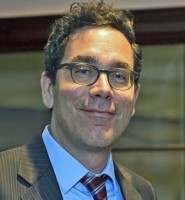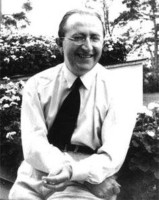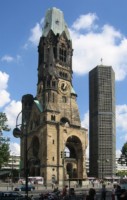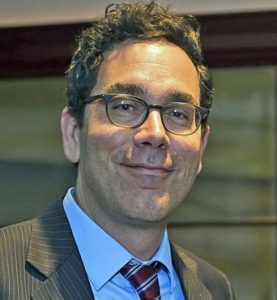Author’s Corner: Gavriel D. Rosenfeld

On Wednesday, September 14, 2016, author and Fairfield University Professor of History Dr. Gavriel D. Rosenfeld will deliver remarks about Duki Dror‘s film MENDELSOHN’S INCESSANT VISIONS in connection with a screening of the movie at the Leo Baeck Institute, NYC. The film is about the influential German-Jewish architect Erich Mendelsohn.
The event is free to the public, but note that the Leo Baeck Institute requests that you R.S.V.P. to reserve your place.
In this interview, I catch up with Dr. Rosenfeld.
1) Please tell us a little about Erich Mendelsohn’s life in Berlin.
Mendelsohn was one of modern architecture’s most notable figures during the Weimar Republic, thanks to his innovative expressionist designs for commercial buildings across the country, from Berlin to Breslau. He ran a very profitable firm, which employed other major modernists, such as the Viennese-born, Richard Neutra, who later migrated to Los Angeles. He left his imprint on Berlin in the form of notable buildings, such as the Mosse-Haus, the Columbushaus, the Metal Workers’ Union Building, and the Universum Cinema.

(The Einstein Tower by Erich Mendelsohn in Potsdam, Germany)
2) I know that the Nazis stole assets from Erich Mendelsohn; do you know whether he ever received any form of restitution from Germany?
Mendelsohn lost all of his assets when he fled Germany for Holland and then England. He later had to rebuild his practice entirely when he emigrated permanently to the United States in 1941. I am not aware of any financial settlements that the architect might have been able to make with the postwar West German government prior to his death in 1953. I know he remained quite bitter about the Nazi experience and was committed to making sure the world did not forget the regime’s crimes against the Jews. In 1951, he turned down a request to participate in an architects’ conference in West Germany by noting, “as long as Germany lacks the courage…to publicly extirpate the anti-cultural things that have occurred in its name and with its silent acquiescence, I as a Jew cannot contribute to the cultural significance of your country.”

(Erich Mendelsohn)
3) Do you have one, or several, favorite structures designed by Erich Mendelsohn? If so, why do you like them?
The only building I’ve seen in person is his Mosse-Haus in Berlin, which once housed the publishing empire of Rudolf Mosse. Many of Mendelsohn’s buildings were destroyed during and after the war, most notably, his Schocken Department Store in Stuttgart, which was torn down in 1960, despite widespread protests. Both buildings, together with his Petersdorff Department store in Breslau (Wroclaw), wonderfully embodied the architect’s trademark use of streamlined forms, which so typified the era’s love of speed and influenced the streamline modern designs of many Art Deco buildings. The Petersdorff building still exists and I would be eager to see it at some point if I ever travel to Poland.
4) Please tell us something about the upcoming volume WHAT IFS OF JEWISH HISTORY; FROM ABRAHAM TO ZIONISM.
I just received my own copies of WHAT IFS OF JEWISH HISTORY, which will be released next month from Cambridge University Press. It is the first book to systematically apply counterfactual reasoning to the study of the Jewish past.
Counterfactual reasoning seeks to determine how history might have been different by exploring events that never happened. In the last generation, counterfactual history has emerged as one of the most innovative — albeit controversial — sub-fields within the western historical profession. Historians have traditionally viewed their task as describing, explaining, and interpreting events that happened in the past. But in recent years they have turned their attention to events that never happened at all. Whether addressing the Civil War, the Third Reich, or the Bolshevik Revolution, they have not only examined these epochal events’ origins and consequences, but speculated about how they might have unfolded differently. With the publication of WHAT IFS OF JEWISH HISTORY, scholars of the Jewish past have finally caught up to scholars in other fields and begun to explore the potential of counterfactual history.
As an historian, I have long been fascinated by historical counter-factuals, both for what their newfound popularity signifies about the state of the historical profession as well as their potential to enrich historical understanding. I have explored “what ifs” related to the Nazi period in several of my books, including THE WORLD HITLER NEVER MADE; ALTERNATE HISTORY AND THE MEMORY OF NAZISM (2005) and HI HITLER! HOW THE NAZI PAST IS BEING NORMALIZED IN CONTEMPORARY CULTURE (2015). Since 2013, I have also edited the blog, The Counterfactual History Review. In all of this work, I have tried to understand the reasons why people try and imagine the past unfolding differently.
5) Can you offer any comments about buildings in Berlin that reflect the ideas you discuss in your book MUNICH AND MEMORY?
In MUNICH AND MEMORY, I examined how the postwar treatment of buildings and memorials in the Bavarian capital reflected the citizenry’s struggle to come to terms with the experience of the Third Reich. Competing memories informed debates over historic preservation, new construction, determining the fate of existing Nazi buildings, and commemorating various aspects of the Nazi dictatorship after 1945. Berlin had many similar debates: for instance, about demolishing or preserving the ruin of the Kaiser-Wilhelm-Gedächtniskirche in West Berlin and the Hohenzollern Stadtschloss in East Berlin (the former was preserved as a ruin; the latter was torn down but is now being rebuilt). Examining the debates about these and countless other episodes reveals a great deal about how postwar Germans saw historical (and not merely aesthetic) significance in buildings. There’s a very rich literature about postwar Berlin architecture, much of it in English, that chronicles many of these debates. My own book, BEYOND BERLIN, which I co-edited with Paul Jaskot in 2008, surveyed how a range of cities across West and East Germany struggled to come to grips with the Nazi era in the urban environment.

(The Kaiser Wilhelm Memorial Church in Berlin)
6) What are you working on now?
I am currently writing a book on the history of the Fourth Reich. This is a project that has many counterfactual dimensions, insofar as it studies something that never came into existence. Since the 1930s, however, the notion of a “Fourth Reich” has enjoyed immense resonance both in German and western political, intellectual, and cultural life. I trace the concept’s evolution both in political discourse and cultural life (focusing especially on literature, film, and television) in order to examine the lifespan of a concept that continues to haunt the western imagination.
I am also researching a larger study on the history of counterfactual history. Although historians routinely pontificate about the virtues and vices of wondering “what if?” about the past, we still lack a methodical study of how historians have actually employed such speculative thinking in their work. I hope to fill this gap by writing a history of how “what if” history has actually been practiced.
*****
(Ed. — You may view the trailer for MENDELSOHN’S INCESSANT VISIONS here. Don’t forget to R.S.V.P. to the free film screening with remarks by Dr. Gavriel D. Rosenfeld here).
